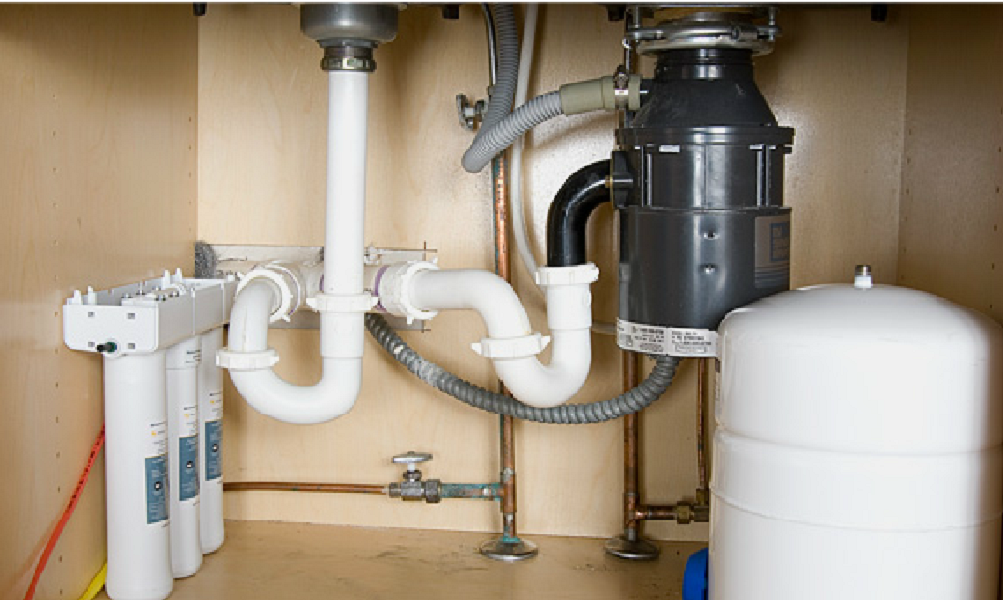When we bought our house in South San José, I learned that we were on Great Oaks water. Having experienced that when I lived in my first condo, I knew the water was hard, and had a “taste”. (it is well water)
While there was a filtration system, it was a simple cartridge system, and by how frozen the cartridges were to the manifold, it was clear that it had been installed and neglected for a long time (so long, that the cartridges went end of life and couldn’t be replaced).
I looked for a little better system, and bought a Whirlpool Reverse Osmosis system for the under sink filtration. I will admit defeat on the installation (I hate plumbing), so we hired a handyman to get it fitted in July 2015.
It worked well. It had three cartridges, with a little reminder (a battery powered timer that lasts amazingly close to 6 months, the recommended change interval), and you could replace the pre / post filter cartridges and the membrane separately (I changed the pre / post every 6 months, and the membrane annually). It had a pressurized reservoir for instant delivery, and it worked well.
By now, you might be detecting the past-tense in this post. That is not a grammar error.
 Last Wednesday night, Barbara noticed that water was pooling under the kitchen sink, and apparently it was coming from the reservoir. So she emptied the under-sink cabinet, put a towel in and left me a message to turn it off.
Last Wednesday night, Barbara noticed that water was pooling under the kitchen sink, and apparently it was coming from the reservoir. So she emptied the under-sink cabinet, put a towel in and left me a message to turn it off.
In the morning I turned off the water supply (that also turned off the cold water delivery to the kitchen – a suboptimal situation). After work, I rolled up my sleeves (figuratively) and got down to diagnosing it.
The RO system is pretty simple, it is plumbed with µ-line tubing and insertion locks. I assumed that it was one of the lock fittings that was the leak and that removing/trimming the tubing would be enough to fix it. Alas, that is not the case.
 The problem is that the manifold, which is cast from plastic, has stress fractures around two of its 4 junctures. These fractures are the source of leaks, and are not repairable. Sure, I can buy a replacement manifold from Whirlpool, and install it myself (and add new filters) but it will just fail again, as the problem is a design issue, and the fractures are stress related.
The problem is that the manifold, which is cast from plastic, has stress fractures around two of its 4 junctures. These fractures are the source of leaks, and are not repairable. Sure, I can buy a replacement manifold from Whirlpool, and install it myself (and add new filters) but it will just fail again, as the problem is a design issue, and the fractures are stress related.
Why did I pick this? Well, we were just moving in, and at the local Orchard Supply Hardware, buying the usual bits you need for a new house (to us), and it was there, the price was reasonable, and the brand Whirlpool, was a comfort. Alas, it was an impulse, and had I done any real research, I would have learnt that they commonly fail at the 1 year mark. The fact that we got better than 2 years was a bonus, but still a disappointment. The unit we had in Tucson was flawless for the 10 years we lived there (and it was there when we originally moved in).
The “Pros”
- It was not too expensive – about $200 if I recall
- It did a great job of filtering the water – coffee tasted noticeably better with the RO water than without (and verified now that I am using plain tap water for coffee)
- It was stupid easy to replace filters. Quick release, and cutoff valves at the manifold meant that it was fast, and not messy
- filters were easy to buy, Amazon sells them, in two kits, one with the pre/post filters, one with all three
- The reminder light (a simple circuit with a CR2032 battery – included with the filter packs) was a visible reminder to replace the filters
The “Cons”
- It failed. The manifold cast of plastic has improper stress relief on the quick-connectors for the tubing
- It was complicated to install. Seriously, too much of the switching happened in the head unit (the “tap”) and getting it properly installed on the kitchen sink was beyond my skills. That, plus I hate plumbing and I ended up calling a handyman
- the filters are about 2x the cost of traditional cartridge filters. The cost of convenience.
Summary
I can’t recommend the Whirlpool WHER25 Reverse Osmosis under sink filtration and conditioning system. While it is true that when it works, it works well, from reading the deluge of negative reviews online, one can’t help but think that Whirlpool got this wone wrong. A moderate price, decent performance, and simple maintenance can’t overcome its huge design flaw – poor stress relief in the manifold.
I will be replacing this with a different unit, it will cost more, and likely be a bit trickier to maintain, but it will certainly not share the same design issues of the WHER25.
If you have a WHER25 today, keep an eye on the manifold for the start of problems, as it is more a a “when” than an “if” it fails. At least it didn’t fail spectacularly.
